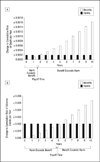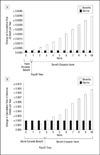A framework for tailoring clinical guidelines to comorbidity at the point of care - PubMed (original) (raw)
A framework for tailoring clinical guidelines to comorbidity at the point of care
R Scott Braithwaite et al. Arch Intern Med. 2007.
Abstract
Background: Evidence is accumulating to suggest that clinical guidelines should be modified for patients with comorbidities, yet there is no quantitative and objective approach that considers benefits together with risks.
Methods: We outline a framework using a payoff time, which we define as the minimum elapsed time until the cumulative incremental benefits of a guideline exceed its cumulative incremental harms. If the payoff time of a guideline exceeds a patient's comorbidity-adjusted life expectancy, then the guideline is unlikely to offer a benefit and should be modified. We illustrate the framework by applying this method to colorectal cancer screening guidelines for 50-year-old men with human immunodeficiency virus (HIV) and 60-year-old women with congestive heart failure (CHF).
Results: We estimated that colorectal cancer screening payoff times for 50-year-old men with HIV would range from 1.9 to 5.0 years and that colorectal cancer screening payoff times for 60-year-old women with CHF would range from 0.7 to 2.9 years. Because the payoff times for 50-year-old men with HIV were lower than their life expectancies (12.5-24.0 years), colorectal cancer screening may be beneficial for these patients. In contrast, because payoff times for 60-year-old women with CHF were sometimes greater than their life expectancies (0.6 to >5 years), colorectal cancer screening is likely to be harmful for some of these patients.
Conclusion: Use of a payoff time calculation may be a feasible framework to tailor clinical guidelines to the comorbidity profiles of individual patients.
Figures
Figure 1
Payoff time for colorectal cancer screening for 50-year-old men, considering (A) mortality and (B) adverse events. The payoff time is the earliest time when the likelihood of benefit (decrease in cumulative risk of adverse outcomes mitigated by screening) exceeds the likelihood of harm (increase in cumulative risk of adverse outcomes induced by screening, ie, its complications and side effects). The payoff time, which occurs when the height of the open bars first exceeds the height of the solid bars, is approximately 1.9 years for mortality and 5.0 years for adverse events.
Figure 2
Payoff times for colorectal cancer screening for 60-year-old women, considering (A) mortality and (B) adverse events. The payoff time is the earliest time when the likelihood of benefit (decrease in cumulative risk of adverse outcomes mitigated by screening) exceeds the likelihood of harm (increase in cumulative risk of adverse outcomes induced by screening, ie, its complications and side effects). The payoff time, which occurs when the height of the open bars first exceeds the height of the solid bars, is approximately 0.7 years for mortality and 2.9 years for adverse events.
Comment in
- The next frontier: quantifying risks for interventions with no end in sight.
Durso S. Durso S. Arch Intern Med. 2008 Jun 9;168(11):1230-1; author reply 1231. doi: 10.1001/archinte.168.11.1230-b. Arch Intern Med. 2008. PMID: 18541837 No abstract available.
Similar articles
- The next frontier: quantifying risks for interventions with no end in sight.
Durso S. Durso S. Arch Intern Med. 2008 Jun 9;168(11):1230-1; author reply 1231. doi: 10.1001/archinte.168.11.1230-b. Arch Intern Med. 2008. PMID: 18541837 No abstract available. - The payoff time: a flexible framework to help clinicians decide when patients with comorbid disease are not likely to benefit from practice guidelines.
Braithwaite RS, Fiellin D, Justice AC. Braithwaite RS, et al. Med Care. 2009 Jun;47(6):610-7. doi: 10.1097/MLR.0b013e31819748d5. Med Care. 2009. PMID: 19433991 Free PMC article. - Can life expectancy and QALYs be improved by a framework for deciding whether to apply clinical guidelines to patients with severe comorbid disease?
Braithwaite RS. Braithwaite RS. Med Decis Making. 2011 Jul-Aug;31(4):582-95. doi: 10.1177/0272989X10386117. Epub 2011 Feb 10. Med Decis Making. 2011. PMID: 21310855 - Cascade colorectal cancer screening guidelines: a global conceptual model.
Winawer SJ, Krabshuis J, Lambert R, O'Brien M, Fried M; World Gastroenterology Organization Guidelines Committee. Winawer SJ, et al. J Clin Gastroenterol. 2011 Apr;45(4):297-300. doi: 10.1097/MCG.0b013e3182098e07. J Clin Gastroenterol. 2011. PMID: 21301355 Review. - Screening for cancer: when to stop?: A practical guide and review of the evidence.
Soung MC. Soung MC. Med Clin North Am. 2015 Mar;99(2):249-62. doi: 10.1016/j.mcna.2014.11.002. Epub 2014 Dec 23. Med Clin North Am. 2015. PMID: 25700582 Review.
Cited by
- HIV/AIDS, comorbidity, and alcohol: can we make a difference?
Justice A, Sullivan L, Fiellin D; Veterans Aging Cohort Study Project Team. Justice A, et al. Alcohol Res Health. 2010;33(3):258-66. Alcohol Res Health. 2010. PMID: 23584067 Free PMC article. Review. - Competing risk and heterogeneity of treatment effect in clinical trials.
Kent DM, Alsheikh-Ali A, Hayward RA. Kent DM, et al. Trials. 2008 May 22;9:30. doi: 10.1186/1745-6215-9-30. Trials. 2008. PMID: 18498644 Free PMC article. - A framework for crafting clinical practice guidelines that are relevant to the care and management of people with multimorbidity.
Uhlig K, Leff B, Kent D, Dy S, Brunnhuber K, Burgers JS, Greenfield S, Guyatt G, High K, Leipzig R, Mulrow C, Schmader K, Schunemann H, Walter LC, Woodcock J, Boyd CM. Uhlig K, et al. J Gen Intern Med. 2014 Apr;29(4):670-9. doi: 10.1007/s11606-013-2659-y. Epub 2014 Jan 18. J Gen Intern Med. 2014. PMID: 24442332 Free PMC article. Review. - A theoretical framework for multimorbidity: from complicated to chaotic.
Kernick D. Kernick D. Br J Gen Pract. 2012 Sep;62(602):e659-62. doi: 10.3399/bjgp12X654740. Br J Gen Pract. 2012. PMID: 22947588 Free PMC article. No abstract available. - Patient-centered care for people living with multimorbidity.
Boyd CM, Lucas GM. Boyd CM, et al. Curr Opin HIV AIDS. 2014 Jul;9(4):419-27. doi: 10.1097/COH.0000000000000073. Curr Opin HIV AIDS. 2014. PMID: 24871089 Free PMC article. Review.
References
- Durso SC. Using clinical guidelines designed for older adults with diabetes mellitus and complex health status. JAMA. 2006;295(16):1935–1940. - PubMed
- Holmes HM, Hayley DC, Alexander GC, Sachs GA. Reconsidering medication appropriateness for patients late in life. Arch Intern Med. 2006;166(6):605–609. - PubMed
- Walter LC, Covinsky KE. Cancer screening in elderly patients: a framework for individualized decision making. JAMA. 2001;285(21):2750–2756. - PubMed
- Boyd CM, Darer J, Boult C, Fried LP, Boult L, Wu AW. Clinical practice guidelines and quality of care for older patients with multiple comorbid diseases: implications for pay for performance. JAMA. 2005;294(6):716–724. - PubMed
- Tinetti ME, Bogardus ST, Jr, Agostini JV. Potential pitfalls of disease-specific guidelines for patients with multiple conditions. N Engl J Med. 2004;351(27):2870–2874. - PubMed

